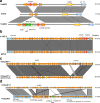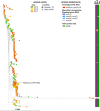Unexpected relationships between frequency of antimicrobial resistance, disease phenotype and emm type in group A Streptococcus
- PMID: 31755853
- PMCID: PMC6927302
- DOI: 10.1099/mgen.0.000316
Unexpected relationships between frequency of antimicrobial resistance, disease phenotype and emm type in group A Streptococcus
Abstract
Despite universal susceptibility to β-lactams, resistance to second-line antimicrobials (e.g. erythromycin) is increasingly common among group A Streptococcus (GAS). To better understand the frequency of regional GAS antimicrobial resistance, we screened a previously described GAS strain collection from Houston, TX, USA, for resistance to commonly used antimicrobials. A total of 100/929 (10.8 %) showed resistance to at least one antimicrobial. Tetracycline resistance was identified in 52 (5.6 %) GAS strains. The cumulative frequency of erythromycin and clindamycin resistance [macrolide (M) and macrolide-lincosamide-streptogramin (MLS) phenotypes] was greatest among invasive GAS strains (9.9 %) compared to that of strains derived from any other infection type (5.9 %, P=0.045). We identified emm types 11, 75, 77 and 92 as the only emm types with high (e.g. >50 %) within-emm type resistance and contributing to the majority (24/26; 92 %) of erythromycin/clindamycin resistance in invasive GAS. High-frequency resistance emm types were also significantly overrepresented in invasive GAS strains as indicated by invasive index. We performed whole-genome sequencing to define genetic elements associated with resistance among emm types 11, 75, 77 and 92. Diverse mobile elements contributed to GAS resistance including transposons, integrative conjugative elements, prophage and a plasmid. Phylogenetic analysis suggests recent clonal emergence of emm92 GAS strains. Our findings indicate that less frequently encountered GAS emm types disproportionately contribute to resistance phenotypes, are defined by diverse mobile genetic elements and may favour invasive disease.
Keywords: antimicrobial resistance; emm type; group A Streptococcus; invasive; pharyngitis; skin and soft tissue.
Conflict of interest statement
The authors declare that there are no conflicts of interest.
Figures



References
-
- Pickering LK, Baker CJ, Kimberlin DW, Long SS, editors. Red Book. 29th edn. Elk Grove Village, IL: American Academy of Pediatrics; 2012.
Publication types
MeSH terms
Substances
Grants and funding
LinkOut - more resources
Full Text Sources
Medical

